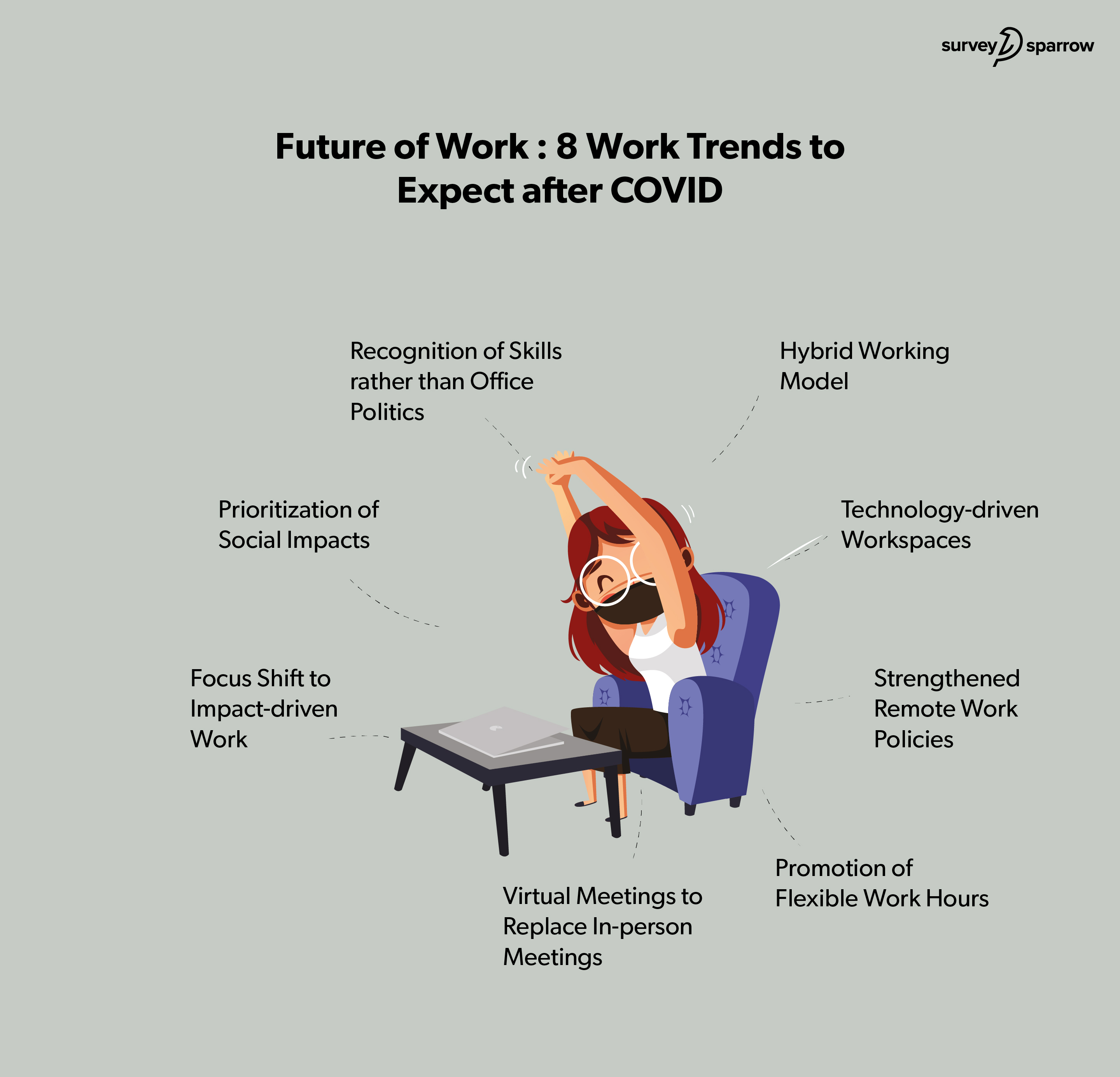COVID-19 crisis came as a sudden blow to the business world and has left many organizations still grasping at straws. The routined work schedules had been turned topsy-turvy in a moment which finally resulted in many companies adopting the drastic changes that came along the way while jeopardizing the existence of some others.
Organizations all over the world are fighting the crisis and innovating work models to suit the present circumstances. Well, these changes are questioning the rudimentary functioning of organizational work and are acting as catalysts to reshape the future of work after COVID-19.
What is the Future of Work After COVID-19: 8 Work Trends to Expect
We have done our bit of research and tried to look into what the future has in store for employees and employers alike. Here are the 8 aspects that can trend and remodel the future of work post COVID-19.

1. Hybrid Workspaces: The New Normal for Employees
“Would the in-office model of working prevail?”
“Will Remote Work take over the current working model?”
These are the questions that have been making the rounds ever since the crisis brought drastic changes in the working patterns across the globe. Even the most reluctant of companies had been forced to implement a combination of in-office, remote, and semi-remote working models due to the limitations imposed by the pandemic. In short, hybrid workspaces are gradually coming into vogue and we anticipate this model to dominate the future. Here’s why.
Hybrid Workspaces empower employee autonomy and flexibility in the way they work. This model lets employees decide on three main factors that can affect productivity: when, where, and how to work in the best possible way that can help create an equilibrium in both work and personal life. SurveySparrow improved its employee pulse by rolling out employee engagement surveys and employee satisfaction surveys. You can sign up for free on SurveySparrow to start using these right away.
14-day free trial • Cancel Anytime • No Credit Card Required • No Strings Attached
Well, we know that many of you might have expected an all-remote workspace to come up in the future. But here’s what we found. Though around 48% of employees are expected to work remotely even post COVID-19, there is yet a 52% who wants otherwise, which is why hybrid working can be the ultimate all-encompassing working model for the future.
It is evident that even employers have taken a liking to this unexpected evolution in work, since, again, 60% of companies report an increase in individual employee productivity. Judging by these trends, hybrid workspaces are getting decked up to take over the future of work after COVID-19.
2. Technology-driven Workspaces: Welcoming Extensive Data Collection
When offices were bustling with staff before, employers and managers could simply stop by an employee’s cabin and opine on their work or even assess it, but now considering the present scenario, the aforementioned is not a viable option.
Since the outbreak, employers have been switching to various technologies to power up the functioning of their organization. From virtual attendance systems to employee engagement software (for assessing employee engagement); SaaS tools have made all this too breezy for companies worldwide. Gartner observes that currently, 6-way employers are depending on technology more frequently than ever to supervise their workforce.
Well, of course, there were organizations using unconventional tools for tracking employee productivity, attendance, and other data even before the crisis.
This trend is about to escalate into the future owing to the burgeoning numbers in remote and hybrid working.
Hence, we predict that companies will indeed be resorting to technology to monitor and track various important data associated with the productivity of their employees even after COVID-19.
3. Remote Work Policies: Renewed and Fortified
Well, this shouldn’t have come as a surprise. We all know remote working is here to stay. In fact, 74% of companies are planning to permanently incorporate remote work post COVID-19. A decade or so ago, ‘work from home’ was nothing more than an eccentric term, but today we know that it plays a huge role in the future employment trends.
The remote working policies of many companies were enforced with restrictions due to fear of performance deterioration, but that was until the crisis. The current remote work status of employees around the world obliviates all these fears. Remote workers are 35-40% more productive now and this percentile is actually expected to grow.
Due to this progress, companies will encourage remote work even after COVID-19 and revisit remote work policies to make it more flexible and relevant in workspaces. Big fishes like Twitter have already amended their remote work policies in regards to their shift to a ‘distributed workforce’.
This move to a 'distributed workforce' is also redefining talent acquisition. As companies formalize these policies, many executives are strategically building dedicated offshore teams, often turning to a specialized remote staffing agency to ensure new teams are high-performing and fully integrated from the start.
4. Flexible Work Hours: The Descend of 9 -to- 5
As far as work is concerned, COVID-19 has brought positive impacts as well. Today, employees and employers work on the foundation of mutual trust and respect. Without the physical boundaries of office space, we see employers relaxing constraints and promoting flexible work hours. The 9 -to-5 timing is slowly fading away, much to the delight of workers.
With increased flexibility, employees are not only able to balance work and personal life but enhance mental health and increase productivity.
In fact, the research of Flex + Strategy Group finds that a whopping 60% of employees with flexible work options feel they are more productive than ever. Ergo, we reckon that the future of work after COVID-19 will be governed by flexible work hours as well.
5. Virtual Meetings: Replacing In-Person Meetings
Virtual collaborative platforms like Slack, Microsoft Teams, etc. have enhanced the productivity of remote working. From stand-ups to meetings, these tools have made working from home a cinch; a relief to both employers and employees. Concerns can be addressed, ideas can be exchanged, work progress can be updated; you can do almost everything carried out in an in-person meeting.
Is it a face-to-face meeting that you prefer? Well, then there’s Zoom and Google Meet to fulfill your wishes. Video Conferencing has emerged as a powerful tool in the present scenario. An invite and a few clicks. That’s all it takes. Now would you want to cram a chair into your already filled meeting room? Of course, not. This is why virtual meetings are going to have a place in the future of work post COVID-19.
6. Impact-Driven Work: Focus Shifts to Outputs Rather than Inputs
A few months back, employee productivity depended a lot on his/her time on the desk, the leaves taken and many other visual aspects that could be tracked by the ‘eyes’ of the manager. But with the crisis, all these norms have been flipped upside down.
Managers no longer have access to check what their employees are doing except depending solely on results and impacts brought to their business by employees, which also lets them measure productivity truly. This gives the employees a chance to prove their worth without being supervised every now and then. Being a win-win situation for both the parties, impact-driven work will be the future.
7. Social Impacts: A New Addition to Priorities
When the first wave of coronavirus hit the world, you could see companies and corporates literally burning the midnight oil to mitigate the situation. While some organizations like Reliance and Tata Group donated money, masks, and sanitizers, the others sat down to create free tools to help NGOs and fellow organizations overcome the situation. The free self-help portal created by SurveySparrow is one such example.
When social good blends with productivity and profits, the impact is surreal. The entire world is given a chance to heal and grow together with the companies. Moreover, customers and even employees connect deeply with organizations that stick to values and work towards it. The world you see today is an example of the statement. The result of prioritizing social good has been great throughout and is helping people fight the hard times. Well, we do think this uplifting trend will be followed and social impacts will be a priority even in the future.
Customers and employees connect deeply with organizations that stick to values.
8. Skill Recognition: Downfall of Office Politics
With hybrid working, being the new normal, office politics will decline and skills will lead the future of work. Well, we know it sounds too good to be true but we do anticipate this change in the coming years.
As we mentioned before, visual checklists are going to be a past story. Managers need not essentially see what employees are doing to measure their engagement and productivity at work. Results-driven by skills will do the talking from now on.
In fact, the current work from home scenario has pushed companies to follow planned, organized, and unbiased processes. The focus has been shifted to metrics that drive impacts. If employees bring amazing results, they can turn the tide no matter how bad they are at marketing themselves.
Well, these are the trends that we think will reign over the future of work after the COVID-19 pandemic subsides. We understand that ‘post COVID’ seems to be far fetched for many, but we believe the day is sure to come. We don’t know how soon, but we certainly know that a pandemic-free future awaits us. When it does, we sincerely hope that companies carefully filter the good and bad from the COVID-affected work scenario and incorporate it into their work life. If so much is decided, the future of work is bright!
Until then, stay safe folks!






